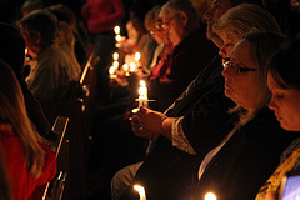
Candlelight vigil in West, Texas, Thursday, April 19, 2013
Credit: Filipa Rodrigues/KUT News
By Terrence Henry, KUT News for StateImpact Texas
WEST, TEXAS – It will take weeks, if not months, to determine the exact cause of the fire and explosion. Investigators will also look into any safety or regulatory issues at the plant. But even at this early stage, there are signs that not all was right with the plant. And it’s also brought up questions about how well regulation of facilities like these works in Texas.
For residents in this small community known for its Czech heritage, the West Fertilizer plant had been a decent neighbor. After all, the West Intermediate school was right next to it, says local Deborah Waters.
DEBORAH WATERS: “Everybody plays over there. That track that is right beside the intermediate school, normally at that time of day, there are 20 to 30 people walking the track, kids playing over there.”
After the fire started, the track was evacuated, Waters says. Some twenty minutes later, the plant exploded.
WATERS: “I think most people didn’t even think about it being there, for the most part.”
But there were times when they thought about it, like when they could smell it. Loretta Volcik has lived in West her whole life. She works at Baylor University, where she’s also getting her degree.
LORETTA VOLCIK: “There were times when I was growing up as a kid, that there would be ammonia smells. You know, you’d be playing outside, and your eyes would start watering. And it was like, ‘Uh oh, Fertilizer plant! Time to go in!'”
One such complaint about those smells triggered an investigation by the Texas Commission on Environmental Quality, or TCEQ in 2006. But it wasn’t a swift response, says Elena Craft, a toxicologist with the Environmental Defense Fund.
ELENA CRAFT: “It took the agency 11 days to come out. That’s too long of a time frame. When we have information such that there was a smell of ammonia, that it was coming from a fertilizer plant, that’s a high priority.”
While investigators were there, they found the company had been operating for two years without a necessary air quality permit. Once the company got that permit, the TCEQ never went back. The Commission doesn’t generally pay a visit to facilities like the one in West unless someone complains.
CRAFT: “Historically, fertilizer plants have not been given the level of attention of scrutiny that other industrial or petrochemical facilities have received.”
The plant was regulated by other state and federal agencies. For instance, it was required to file a worst case scenario report with the Environmental Protection Agency, says Kelly Haragan. She’s the Director of the environmental law clinic at the UT Law school. That report outlines the possible public safety issues at a facility like West Fertilizer.
KELLY HARAGAN: “But those reports are kept pretty tightly controlled. You have to go to a federal reading room to see them. You can’t make copies of them. You can bring in a pad of paper and a pencil. That’s it.”
The worst case scenario reports are supposed to be shared with local officials and emergency responders. But that’s not always the case. And they may not tell the full story in the case of a plant like West Fertilizer.
HARAGAN: “The report was filed with the EPA. But it said that there wasn’t a significant fire or explosion hazard at that plant.”
According to records from the Texas Department of State Health Services obtained by StateImpact Texas, the plant had as much as 270 tons of ammonium nitrate at the site in 2012. Another issue in the limelight after the West explosion is how well trained local first responders are to deal with fires and accidents at major industrial facilities. Again, Elena Craft from the Environmental Defense Fund.
CRAFT: “I think that’s a very critical issue of concern here.”
In 2011, a fire started at the Magnablend chemical plant in Waxahachie. But first responders didn’t know what chemicals were inside or that the building didn’t have adequate sprinklers.
CRAFT: “They should know. Because what happens is, you may alter the way that you handle that situation. And I think that these deaths can be avoided.”
Of the fourteen confirmed fatalities in West, at least nine were firefighters and first responders.
Yet another question after the explosion is whether or not industrial facilities should be right next door to schools and residences like the one in West.
HARAGAN: “In Texas, counties have almost no regulatory authority. And we kind of don’t like land use in Texas. So we’ve ended up where facilities are very close to people.”
That’s Kelly Haragan again from UT. She says that regardless of the cause of the West explosion, there’s one thing that could’ve been prevented in any scenario: the plant’s proximity to homes and schools.
HARAGAN: “You hope that we can implement some changes so we don’t have to wait until a plant explodes and people are killed before you come in and try to do what just seems like common sense: people shouldn’t be living so close to some of these industrial facilities.”
When asked at a press conference Friday if the state should be doing more to regulate and properly zone industrial facilities, Governor Rick Perry said he’d look into it.
GOVERNOR RICK PERRY: “Listen, if there’s a better way to do this, we want to know about it. If there’s a better way to deal with these events, we want to have that discussion, whatever that might be.”
Elena Craft says the West disaster is likely to be one of the deadliest industrial accidents in decades in Texas.
CRAFT: “You know, we’ve always touted Texas as a place open for business. The fact is, our jobs should not cost us our life. And that’s what we’ve seen throughout the history of Texas.”




